Individual Report on Little Dessert Shop
VerifiedAdded on 2023/01/03
|9
|2174
|47
AI Summary
This individual report provides an analysis of different types of business organizations and macro environmental factors affecting the Little Dessert Shop. It includes a case study on the shop, answers to specific questions, and a conclusion based on the analysis and research.
Contribute Materials
Your contribution can guide someone’s learning journey. Share your
documents today.

Individual report
Case Study based
Case Study based
Secure Best Marks with AI Grader
Need help grading? Try our AI Grader for instant feedback on your assignments.
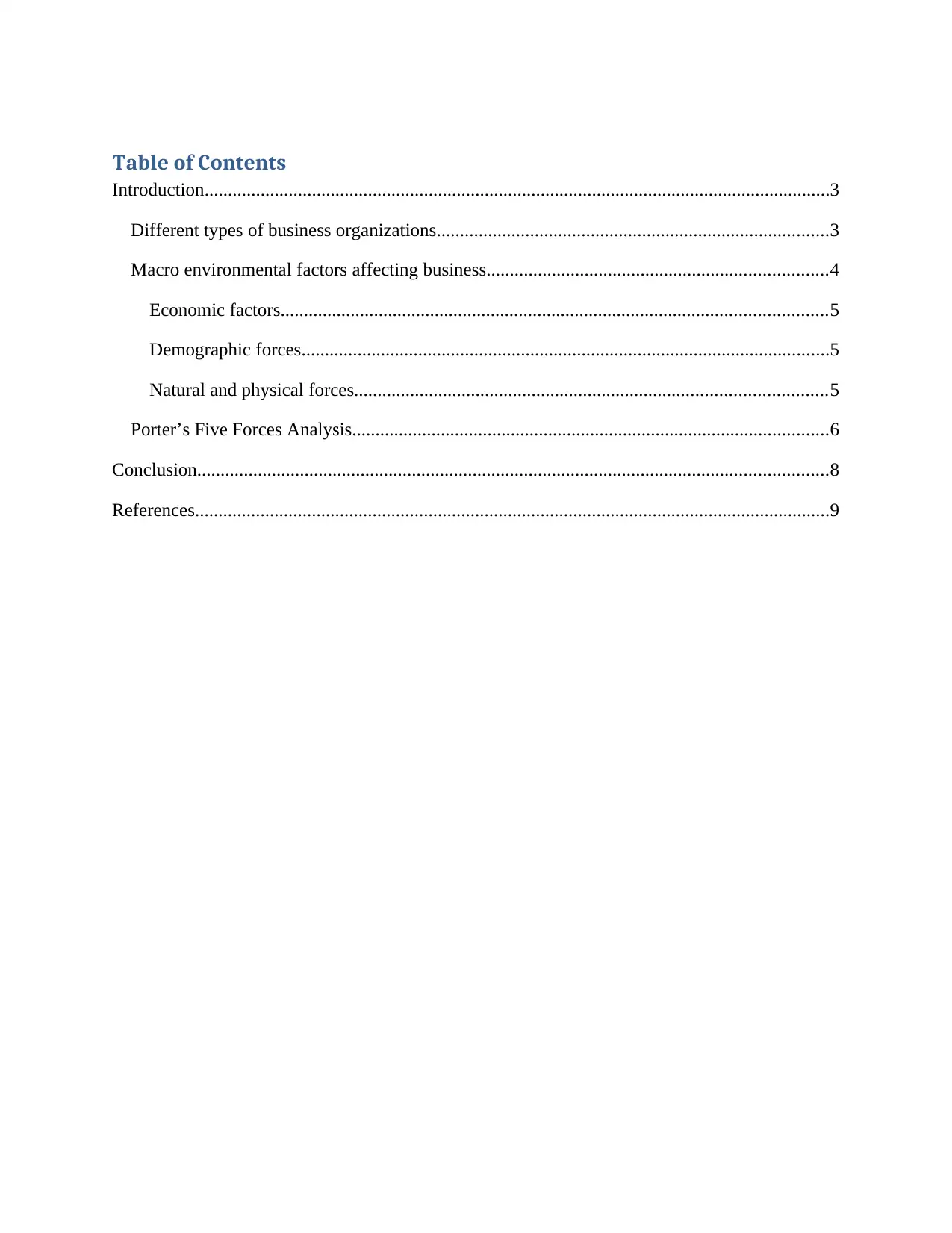
Table of Contents
Introduction......................................................................................................................................3
Different types of business organizations....................................................................................3
Macro environmental factors affecting business.........................................................................4
Economic factors.....................................................................................................................5
Demographic forces.................................................................................................................5
Natural and physical forces.....................................................................................................5
Porter’s Five Forces Analysis......................................................................................................6
Conclusion.......................................................................................................................................8
References........................................................................................................................................9
Introduction......................................................................................................................................3
Different types of business organizations....................................................................................3
Macro environmental factors affecting business.........................................................................4
Economic factors.....................................................................................................................5
Demographic forces.................................................................................................................5
Natural and physical forces.....................................................................................................5
Porter’s Five Forces Analysis......................................................................................................6
Conclusion.......................................................................................................................................8
References........................................................................................................................................9
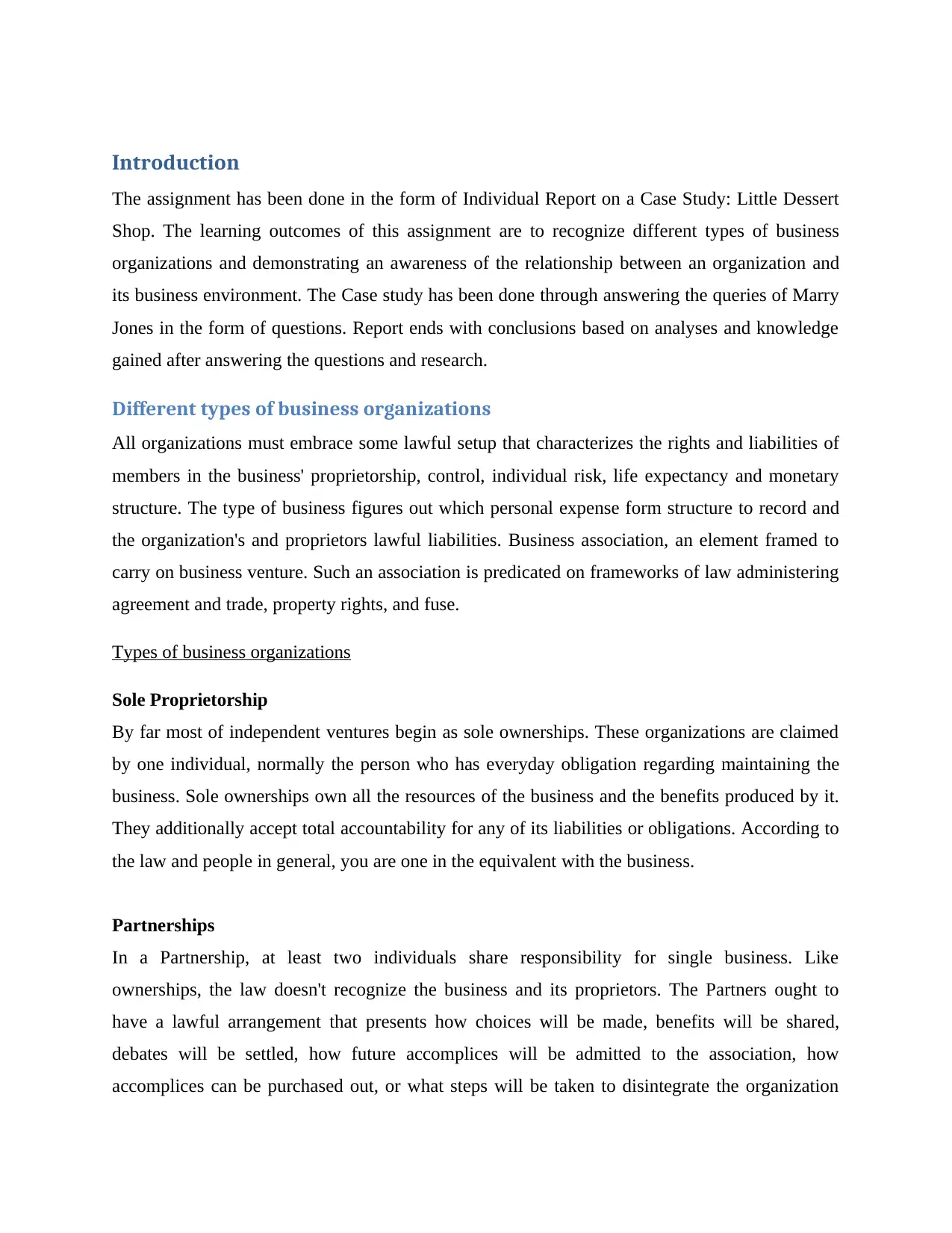
Introduction
The assignment has been done in the form of Individual Report on a Case Study: Little Dessert
Shop. The learning outcomes of this assignment are to recognize different types of business
organizations and demonstrating an awareness of the relationship between an organization and
its business environment. The Case study has been done through answering the queries of Marry
Jones in the form of questions. Report ends with conclusions based on analyses and knowledge
gained after answering the questions and research.
Different types of business organizations
All organizations must embrace some lawful setup that characterizes the rights and liabilities of
members in the business' proprietorship, control, individual risk, life expectancy and monetary
structure. The type of business figures out which personal expense form structure to record and
the organization's and proprietors lawful liabilities. Business association, an element framed to
carry on business venture. Such an association is predicated on frameworks of law administering
agreement and trade, property rights, and fuse.
Types of business organizations
Sole Proprietorship
By far most of independent ventures begin as sole ownerships. These organizations are claimed
by one individual, normally the person who has everyday obligation regarding maintaining the
business. Sole ownerships own all the resources of the business and the benefits produced by it.
They additionally accept total accountability for any of its liabilities or obligations. According to
the law and people in general, you are one in the equivalent with the business.
Partnerships
In a Partnership, at least two individuals share responsibility for single business. Like
ownerships, the law doesn't recognize the business and its proprietors. The Partners ought to
have a lawful arrangement that presents how choices will be made, benefits will be shared,
debates will be settled, how future accomplices will be admitted to the association, how
accomplices can be purchased out, or what steps will be taken to disintegrate the organization
The assignment has been done in the form of Individual Report on a Case Study: Little Dessert
Shop. The learning outcomes of this assignment are to recognize different types of business
organizations and demonstrating an awareness of the relationship between an organization and
its business environment. The Case study has been done through answering the queries of Marry
Jones in the form of questions. Report ends with conclusions based on analyses and knowledge
gained after answering the questions and research.
Different types of business organizations
All organizations must embrace some lawful setup that characterizes the rights and liabilities of
members in the business' proprietorship, control, individual risk, life expectancy and monetary
structure. The type of business figures out which personal expense form structure to record and
the organization's and proprietors lawful liabilities. Business association, an element framed to
carry on business venture. Such an association is predicated on frameworks of law administering
agreement and trade, property rights, and fuse.
Types of business organizations
Sole Proprietorship
By far most of independent ventures begin as sole ownerships. These organizations are claimed
by one individual, normally the person who has everyday obligation regarding maintaining the
business. Sole ownerships own all the resources of the business and the benefits produced by it.
They additionally accept total accountability for any of its liabilities or obligations. According to
the law and people in general, you are one in the equivalent with the business.
Partnerships
In a Partnership, at least two individuals share responsibility for single business. Like
ownerships, the law doesn't recognize the business and its proprietors. The Partners ought to
have a lawful arrangement that presents how choices will be made, benefits will be shared,
debates will be settled, how future accomplices will be admitted to the association, how
accomplices can be purchased out, or what steps will be taken to disintegrate the organization
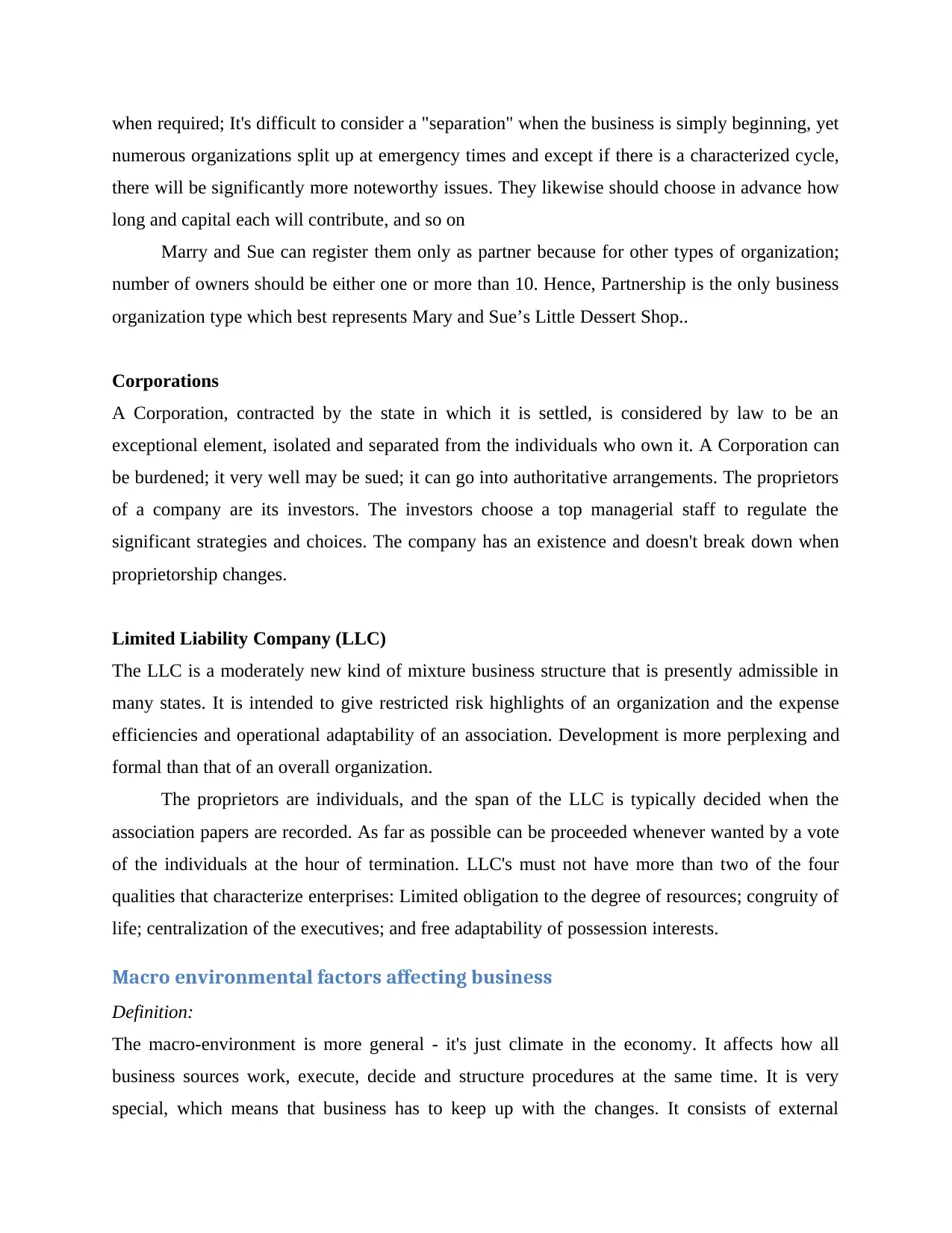
when required; It's difficult to consider a "separation" when the business is simply beginning, yet
numerous organizations split up at emergency times and except if there is a characterized cycle,
there will be significantly more noteworthy issues. They likewise should choose in advance how
long and capital each will contribute, and so on
Marry and Sue can register them only as partner because for other types of organization;
number of owners should be either one or more than 10. Hence, Partnership is the only business
organization type which best represents Mary and Sue’s Little Dessert Shop..
Corporations
A Corporation, contracted by the state in which it is settled, is considered by law to be an
exceptional element, isolated and separated from the individuals who own it. A Corporation can
be burdened; it very well may be sued; it can go into authoritative arrangements. The proprietors
of a company are its investors. The investors choose a top managerial staff to regulate the
significant strategies and choices. The company has an existence and doesn't break down when
proprietorship changes.
Limited Liability Company (LLC)
The LLC is a moderately new kind of mixture business structure that is presently admissible in
many states. It is intended to give restricted risk highlights of an organization and the expense
efficiencies and operational adaptability of an association. Development is more perplexing and
formal than that of an overall organization.
The proprietors are individuals, and the span of the LLC is typically decided when the
association papers are recorded. As far as possible can be proceeded whenever wanted by a vote
of the individuals at the hour of termination. LLC's must not have more than two of the four
qualities that characterize enterprises: Limited obligation to the degree of resources; congruity of
life; centralization of the executives; and free adaptability of possession interests.
Macro environmental factors affecting business
Definition:
The macro-environment is more general - it's just climate in the economy. It affects how all
business sources work, execute, decide and structure procedures at the same time. It is very
special, which means that business has to keep up with the changes. It consists of external
numerous organizations split up at emergency times and except if there is a characterized cycle,
there will be significantly more noteworthy issues. They likewise should choose in advance how
long and capital each will contribute, and so on
Marry and Sue can register them only as partner because for other types of organization;
number of owners should be either one or more than 10. Hence, Partnership is the only business
organization type which best represents Mary and Sue’s Little Dessert Shop..
Corporations
A Corporation, contracted by the state in which it is settled, is considered by law to be an
exceptional element, isolated and separated from the individuals who own it. A Corporation can
be burdened; it very well may be sued; it can go into authoritative arrangements. The proprietors
of a company are its investors. The investors choose a top managerial staff to regulate the
significant strategies and choices. The company has an existence and doesn't break down when
proprietorship changes.
Limited Liability Company (LLC)
The LLC is a moderately new kind of mixture business structure that is presently admissible in
many states. It is intended to give restricted risk highlights of an organization and the expense
efficiencies and operational adaptability of an association. Development is more perplexing and
formal than that of an overall organization.
The proprietors are individuals, and the span of the LLC is typically decided when the
association papers are recorded. As far as possible can be proceeded whenever wanted by a vote
of the individuals at the hour of termination. LLC's must not have more than two of the four
qualities that characterize enterprises: Limited obligation to the degree of resources; congruity of
life; centralization of the executives; and free adaptability of possession interests.
Macro environmental factors affecting business
Definition:
The macro-environment is more general - it's just climate in the economy. It affects how all
business sources work, execute, decide and structure procedures at the same time. It is very
special, which means that business has to keep up with the changes. It consists of external
Secure Best Marks with AI Grader
Need help grading? Try our AI Grader for instant feedback on your assignments.
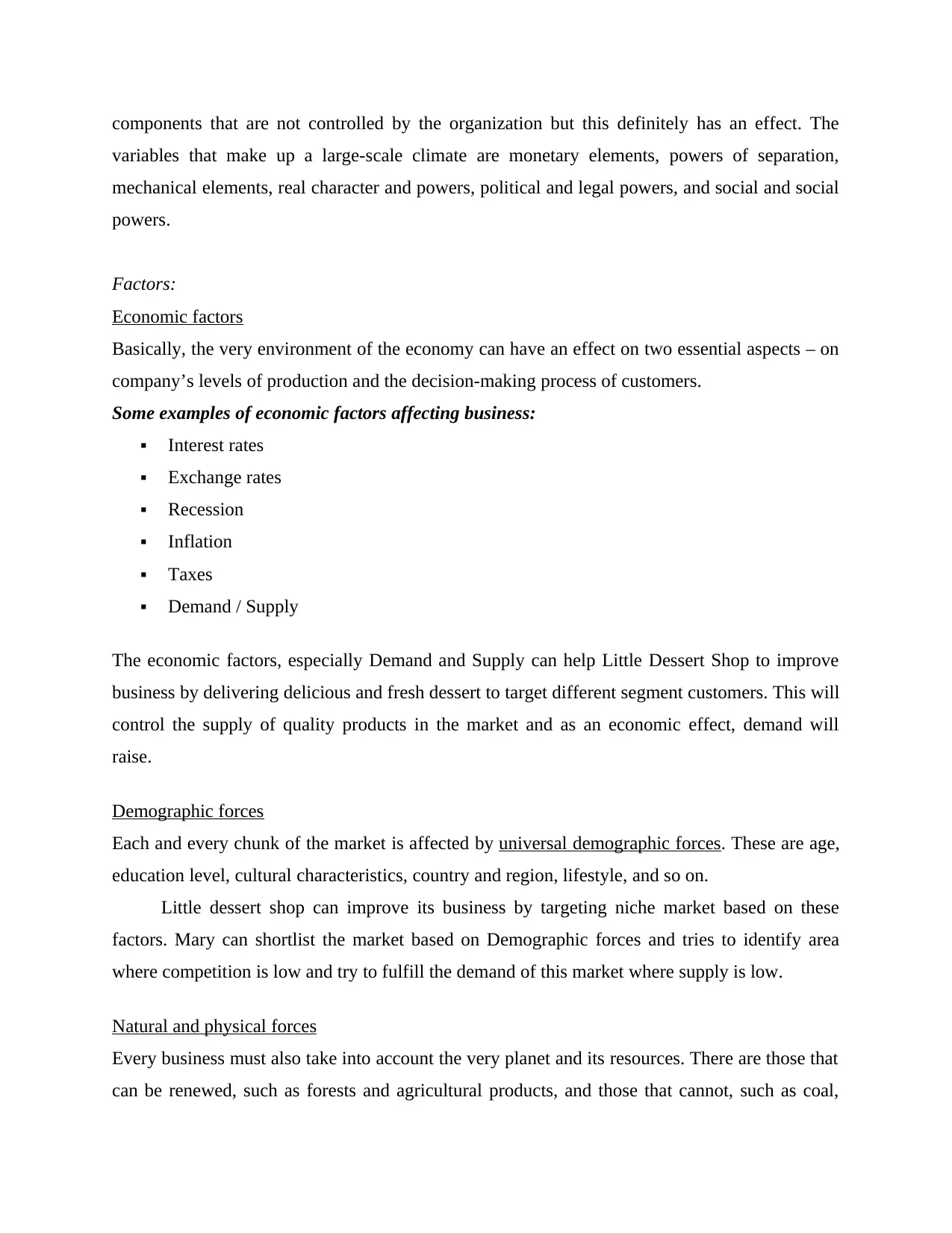
components that are not controlled by the organization but this definitely has an effect. The
variables that make up a large-scale climate are monetary elements, powers of separation,
mechanical elements, real character and powers, political and legal powers, and social and social
powers.
Factors:
Economic factors
Basically, the very environment of the economy can have an effect on two essential aspects – on
company’s levels of production and the decision-making process of customers.
Some examples of economic factors affecting business:
Interest rates
Exchange rates
Recession
Inflation
Taxes
Demand / Supply
The economic factors, especially Demand and Supply can help Little Dessert Shop to improve
business by delivering delicious and fresh dessert to target different segment customers. This will
control the supply of quality products in the market and as an economic effect, demand will
raise.
Demographic forces
Each and every chunk of the market is affected by universal demographic forces. These are age,
education level, cultural characteristics, country and region, lifestyle, and so on.
Little dessert shop can improve its business by targeting niche market based on these
factors. Mary can shortlist the market based on Demographic forces and tries to identify area
where competition is low and try to fulfill the demand of this market where supply is low.
Natural and physical forces
Every business must also take into account the very planet and its resources. There are those that
can be renewed, such as forests and agricultural products, and those that cannot, such as coal,
variables that make up a large-scale climate are monetary elements, powers of separation,
mechanical elements, real character and powers, political and legal powers, and social and social
powers.
Factors:
Economic factors
Basically, the very environment of the economy can have an effect on two essential aspects – on
company’s levels of production and the decision-making process of customers.
Some examples of economic factors affecting business:
Interest rates
Exchange rates
Recession
Inflation
Taxes
Demand / Supply
The economic factors, especially Demand and Supply can help Little Dessert Shop to improve
business by delivering delicious and fresh dessert to target different segment customers. This will
control the supply of quality products in the market and as an economic effect, demand will
raise.
Demographic forces
Each and every chunk of the market is affected by universal demographic forces. These are age,
education level, cultural characteristics, country and region, lifestyle, and so on.
Little dessert shop can improve its business by targeting niche market based on these
factors. Mary can shortlist the market based on Demographic forces and tries to identify area
where competition is low and try to fulfill the demand of this market where supply is low.
Natural and physical forces
Every business must also take into account the very planet and its resources. There are those that
can be renewed, such as forests and agricultural products, and those that cannot, such as coal,

minerals, oil, and the like. Both are strongly related to production. So, natural and physical
forces can be:
Climate change
Pollution
Weather
Availability of both non-renewable and renewable resources
Laws that regulate the environment
Survival of particular biological species
This factor could help firm to deliver natural desserts which is pollution free and regulated by the
government. Health conscious people will show their interest to buy from Little Dessert Shop.
Porter’s Five Forces Analysis
The framework for the Five Forces Analysis consists of these competitive forces:
1. Industry rivalry (degree of competition among existing firms)—intense competition leads
to reduced profit potential for companies in the same industry. There is high competition
within Dessert Shop; hence, Mary and Sue require providing uniqueness in their product
to minimize this competition.
2. Threat of substitutes (products or services)—availability of substitute products will limit
the ability to raise prices. Little Dessert Shop has huge competitor, thus, Mary and Sue is
not in the position to increase the prices of the product and they have to sale their services
at comparably low price to survive in the market.
3. Bargaining power of buyers—powerful buyers have a significant impact on prices. Here,
due to large number of Dessert Shop’s; competition is strong and buyer has high
bargaining power.
4. Bargaining power of suppliers—powerful suppliers can demand premium prices and limit
profit. Bargaining power of suppliers is low because there are many suppliers who deliver
best quality Desserts at very cheap rate.
5. Barriers to entry (threat of new entrants)—act as a deterrent against new competitors.
There’s no barriers for entries and because of this, threat of new entrants are high. There
forces can be:
Climate change
Pollution
Weather
Availability of both non-renewable and renewable resources
Laws that regulate the environment
Survival of particular biological species
This factor could help firm to deliver natural desserts which is pollution free and regulated by the
government. Health conscious people will show their interest to buy from Little Dessert Shop.
Porter’s Five Forces Analysis
The framework for the Five Forces Analysis consists of these competitive forces:
1. Industry rivalry (degree of competition among existing firms)—intense competition leads
to reduced profit potential for companies in the same industry. There is high competition
within Dessert Shop; hence, Mary and Sue require providing uniqueness in their product
to minimize this competition.
2. Threat of substitutes (products or services)—availability of substitute products will limit
the ability to raise prices. Little Dessert Shop has huge competitor, thus, Mary and Sue is
not in the position to increase the prices of the product and they have to sale their services
at comparably low price to survive in the market.
3. Bargaining power of buyers—powerful buyers have a significant impact on prices. Here,
due to large number of Dessert Shop’s; competition is strong and buyer has high
bargaining power.
4. Bargaining power of suppliers—powerful suppliers can demand premium prices and limit
profit. Bargaining power of suppliers is low because there are many suppliers who deliver
best quality Desserts at very cheap rate.
5. Barriers to entry (threat of new entrants)—act as a deterrent against new competitors.
There’s no barriers for entries and because of this, threat of new entrants are high. There
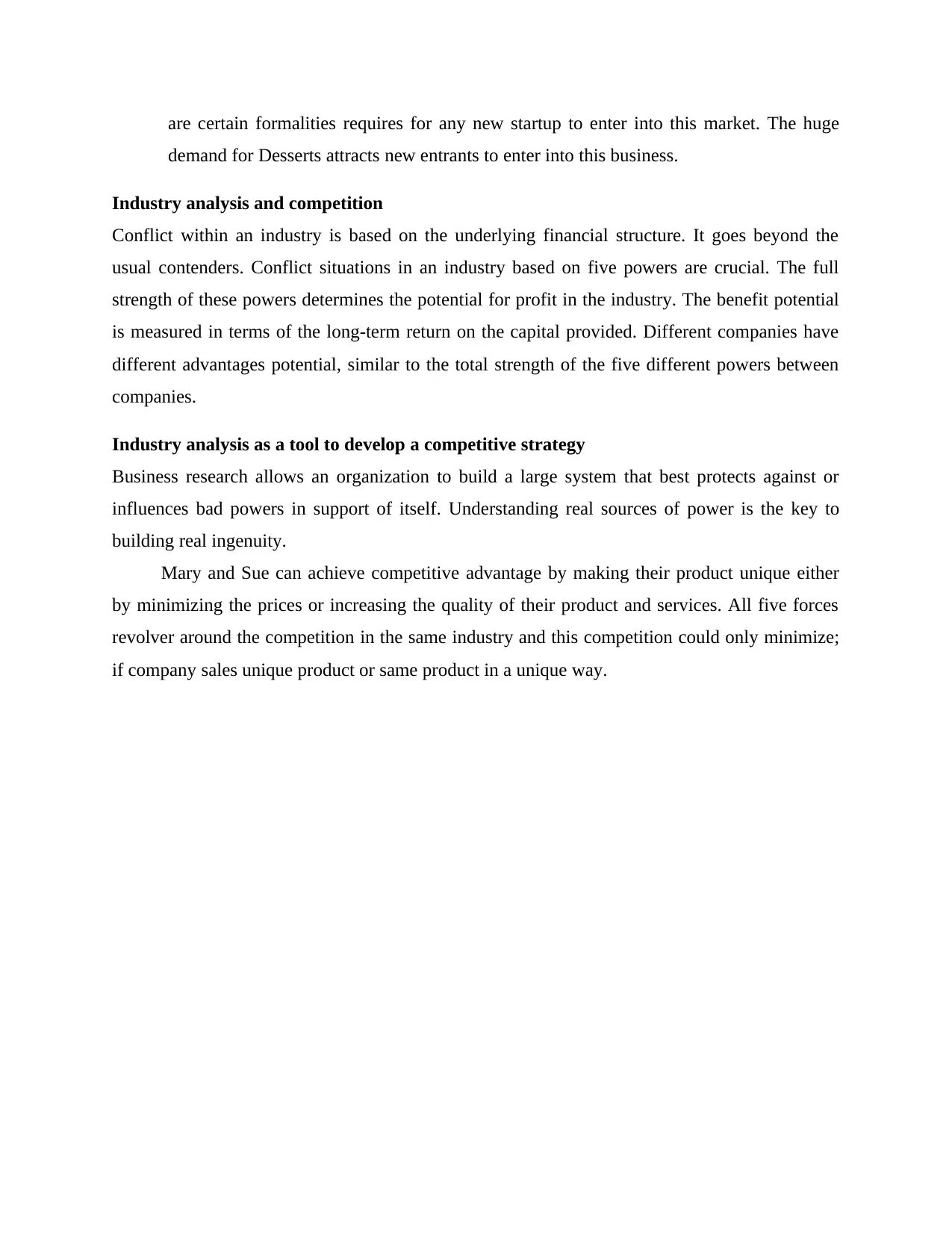
are certain formalities requires for any new startup to enter into this market. The huge
demand for Desserts attracts new entrants to enter into this business.
Industry analysis and competition
Conflict within an industry is based on the underlying financial structure. It goes beyond the
usual contenders. Conflict situations in an industry based on five powers are crucial. The full
strength of these powers determines the potential for profit in the industry. The benefit potential
is measured in terms of the long-term return on the capital provided. Different companies have
different advantages potential, similar to the total strength of the five different powers between
companies.
Industry analysis as a tool to develop a competitive strategy
Business research allows an organization to build a large system that best protects against or
influences bad powers in support of itself. Understanding real sources of power is the key to
building real ingenuity.
Mary and Sue can achieve competitive advantage by making their product unique either
by minimizing the prices or increasing the quality of their product and services. All five forces
revolver around the competition in the same industry and this competition could only minimize;
if company sales unique product or same product in a unique way.
demand for Desserts attracts new entrants to enter into this business.
Industry analysis and competition
Conflict within an industry is based on the underlying financial structure. It goes beyond the
usual contenders. Conflict situations in an industry based on five powers are crucial. The full
strength of these powers determines the potential for profit in the industry. The benefit potential
is measured in terms of the long-term return on the capital provided. Different companies have
different advantages potential, similar to the total strength of the five different powers between
companies.
Industry analysis as a tool to develop a competitive strategy
Business research allows an organization to build a large system that best protects against or
influences bad powers in support of itself. Understanding real sources of power is the key to
building real ingenuity.
Mary and Sue can achieve competitive advantage by making their product unique either
by minimizing the prices or increasing the quality of their product and services. All five forces
revolver around the competition in the same industry and this competition could only minimize;
if company sales unique product or same product in a unique way.
Paraphrase This Document
Need a fresh take? Get an instant paraphrase of this document with our AI Paraphraser
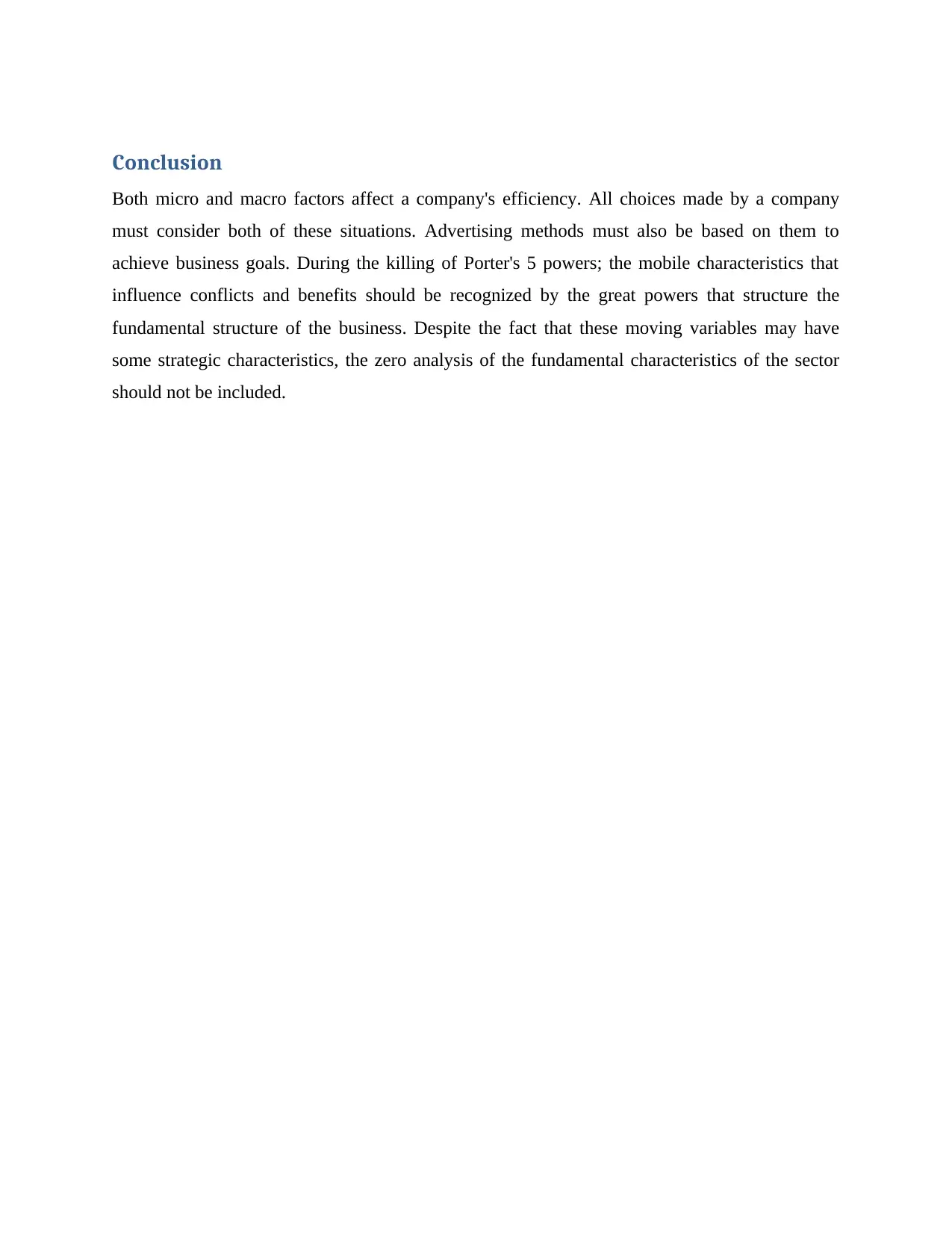
Conclusion
Both micro and macro factors affect a company's efficiency. All choices made by a company
must consider both of these situations. Advertising methods must also be based on them to
achieve business goals. During the killing of Porter's 5 powers; the mobile characteristics that
influence conflicts and benefits should be recognized by the great powers that structure the
fundamental structure of the business. Despite the fact that these moving variables may have
some strategic characteristics, the zero analysis of the fundamental characteristics of the sector
should not be included.
Both micro and macro factors affect a company's efficiency. All choices made by a company
must consider both of these situations. Advertising methods must also be based on them to
achieve business goals. During the killing of Porter's 5 powers; the mobile characteristics that
influence conflicts and benefits should be recognized by the great powers that structure the
fundamental structure of the business. Despite the fact that these moving variables may have
some strategic characteristics, the zero analysis of the fundamental characteristics of the sector
should not be included.
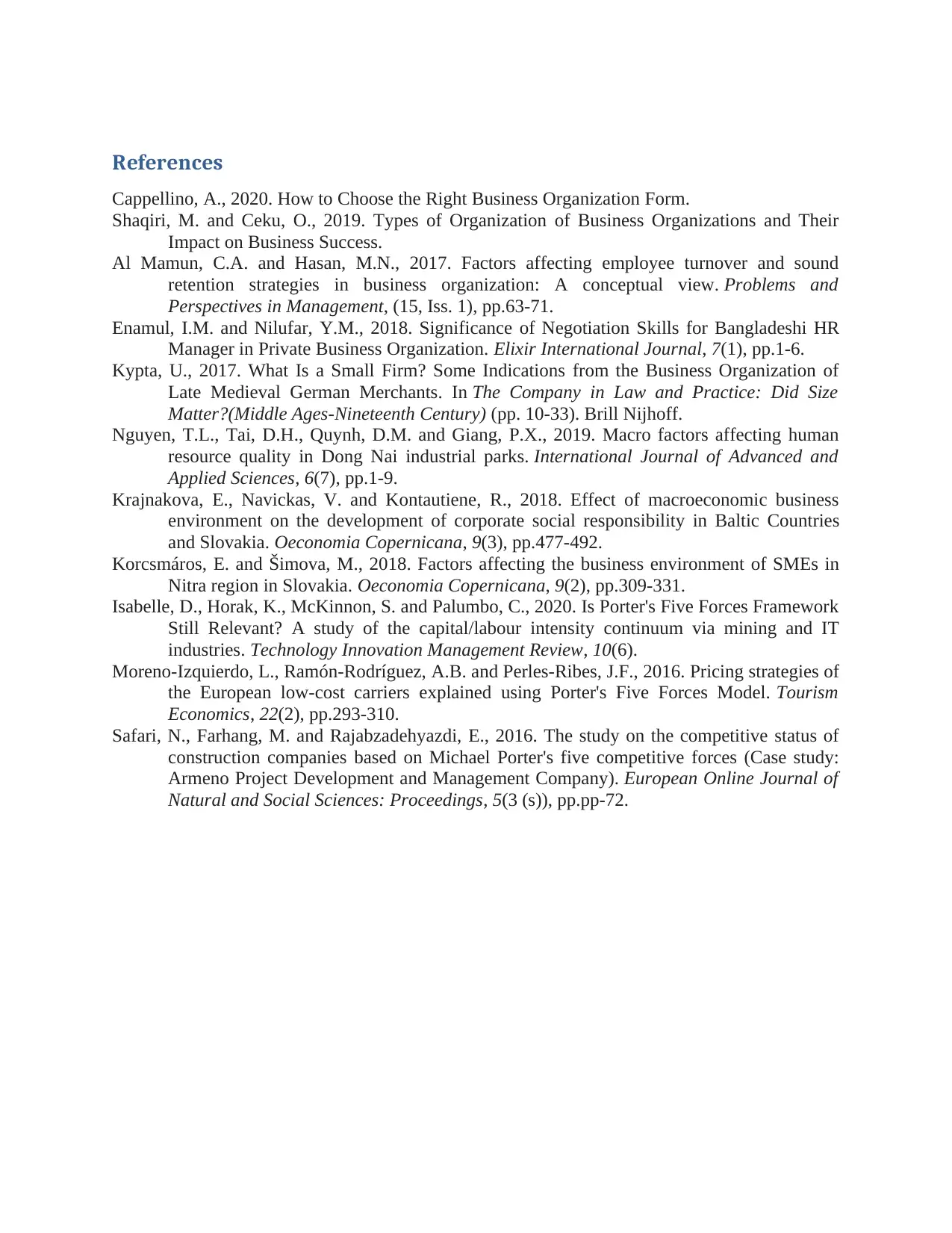
References
Cappellino, A., 2020. How to Choose the Right Business Organization Form.
Shaqiri, M. and Ceku, O., 2019. Types of Organization of Business Organizations and Their
Impact on Business Success.
Al Mamun, C.A. and Hasan, M.N., 2017. Factors affecting employee turnover and sound
retention strategies in business organization: A conceptual view. Problems and
Perspectives in Management, (15, Iss. 1), pp.63-71.
Enamul, I.M. and Nilufar, Y.M., 2018. Significance of Negotiation Skills for Bangladeshi HR
Manager in Private Business Organization. Elixir International Journal, 7(1), pp.1-6.
Kypta, U., 2017. What Is a Small Firm? Some Indications from the Business Organization of
Late Medieval German Merchants. In The Company in Law and Practice: Did Size
Matter?(Middle Ages-Nineteenth Century) (pp. 10-33). Brill Nijhoff.
Nguyen, T.L., Tai, D.H., Quynh, D.M. and Giang, P.X., 2019. Macro factors affecting human
resource quality in Dong Nai industrial parks. International Journal of Advanced and
Applied Sciences, 6(7), pp.1-9.
Krajnakova, E., Navickas, V. and Kontautiene, R., 2018. Effect of macroeconomic business
environment on the development of corporate social responsibility in Baltic Countries
and Slovakia. Oeconomia Copernicana, 9(3), pp.477-492.
Korcsmáros, E. and Šimova, M., 2018. Factors affecting the business environment of SMEs in
Nitra region in Slovakia. Oeconomia Copernicana, 9(2), pp.309-331.
Isabelle, D., Horak, K., McKinnon, S. and Palumbo, C., 2020. Is Porter's Five Forces Framework
Still Relevant? A study of the capital/labour intensity continuum via mining and IT
industries. Technology Innovation Management Review, 10(6).
Moreno-Izquierdo, L., Ramón-Rodríguez, A.B. and Perles-Ribes, J.F., 2016. Pricing strategies of
the European low-cost carriers explained using Porter's Five Forces Model. Tourism
Economics, 22(2), pp.293-310.
Safari, N., Farhang, M. and Rajabzadehyazdi, E., 2016. The study on the competitive status of
construction companies based on Michael Porter's five competitive forces (Case study:
Armeno Project Development and Management Company). European Online Journal of
Natural and Social Sciences: Proceedings, 5(3 (s)), pp.pp-72.
Cappellino, A., 2020. How to Choose the Right Business Organization Form.
Shaqiri, M. and Ceku, O., 2019. Types of Organization of Business Organizations and Their
Impact on Business Success.
Al Mamun, C.A. and Hasan, M.N., 2017. Factors affecting employee turnover and sound
retention strategies in business organization: A conceptual view. Problems and
Perspectives in Management, (15, Iss. 1), pp.63-71.
Enamul, I.M. and Nilufar, Y.M., 2018. Significance of Negotiation Skills for Bangladeshi HR
Manager in Private Business Organization. Elixir International Journal, 7(1), pp.1-6.
Kypta, U., 2017. What Is a Small Firm? Some Indications from the Business Organization of
Late Medieval German Merchants. In The Company in Law and Practice: Did Size
Matter?(Middle Ages-Nineteenth Century) (pp. 10-33). Brill Nijhoff.
Nguyen, T.L., Tai, D.H., Quynh, D.M. and Giang, P.X., 2019. Macro factors affecting human
resource quality in Dong Nai industrial parks. International Journal of Advanced and
Applied Sciences, 6(7), pp.1-9.
Krajnakova, E., Navickas, V. and Kontautiene, R., 2018. Effect of macroeconomic business
environment on the development of corporate social responsibility in Baltic Countries
and Slovakia. Oeconomia Copernicana, 9(3), pp.477-492.
Korcsmáros, E. and Šimova, M., 2018. Factors affecting the business environment of SMEs in
Nitra region in Slovakia. Oeconomia Copernicana, 9(2), pp.309-331.
Isabelle, D., Horak, K., McKinnon, S. and Palumbo, C., 2020. Is Porter's Five Forces Framework
Still Relevant? A study of the capital/labour intensity continuum via mining and IT
industries. Technology Innovation Management Review, 10(6).
Moreno-Izquierdo, L., Ramón-Rodríguez, A.B. and Perles-Ribes, J.F., 2016. Pricing strategies of
the European low-cost carriers explained using Porter's Five Forces Model. Tourism
Economics, 22(2), pp.293-310.
Safari, N., Farhang, M. and Rajabzadehyazdi, E., 2016. The study on the competitive status of
construction companies based on Michael Porter's five competitive forces (Case study:
Armeno Project Development and Management Company). European Online Journal of
Natural and Social Sciences: Proceedings, 5(3 (s)), pp.pp-72.
1 out of 9
Related Documents
Your All-in-One AI-Powered Toolkit for Academic Success.
+13062052269
info@desklib.com
Available 24*7 on WhatsApp / Email
![[object Object]](/_next/static/media/star-bottom.7253800d.svg)
Unlock your academic potential
© 2024 | Zucol Services PVT LTD | All rights reserved.





